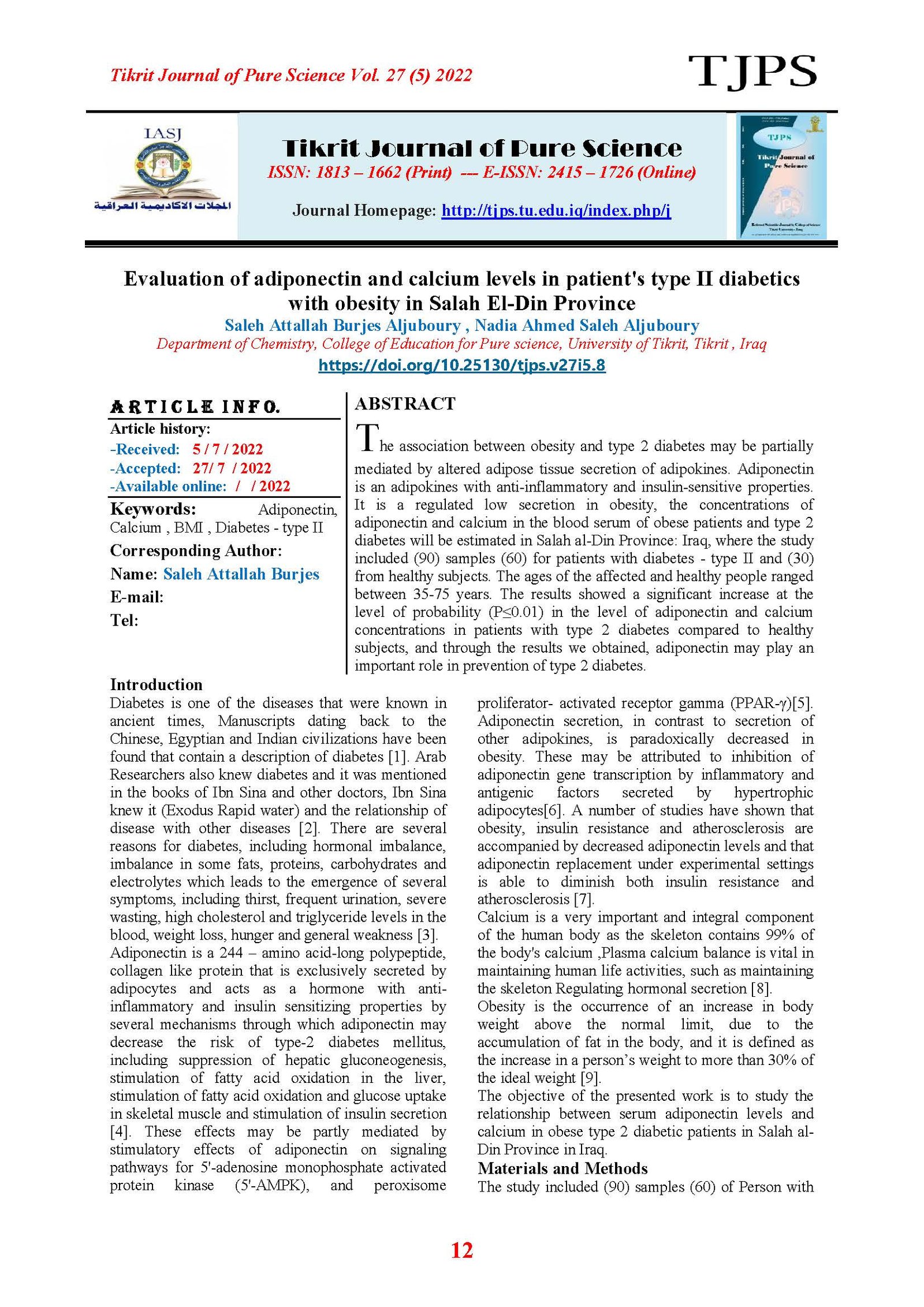Evaluation of adiponectin and calcium levels in patient's type II diabetics with obesity in Salah El-Din Province
Main Article Content
Abstract
The association between obesity and type 2 diabetes may be partially mediated by altered adipose tissue secretion of adipokines. Adiponectin is an adipokines with anti-inflammatory and insulin-sensitive properties. It is a regulated low secretion in obesity, the concentrations of adiponectin and calcium in the blood serum of obese patients and type 2 diabetes will be estimated in Salah al-Din Province: Iraq, where the study included (90) samples (60) for patients with diabetes - type II and (30) from healthy subjects. The ages of the affected and healthy people ranged between 35-75 years. The results showed a significant increase at the level of probability (P≤0.01) in the level of adiponectin and calcium concentrations in patients with type 2 diabetes compared to healthy subjects, and through the results we obtained, adiponectin may play an important role in prevention of type 2 diabetes
Article Details

This work is licensed under a Creative Commons Attribution 4.0 International License.
Tikrit Journal of Pure Science is licensed under the Creative Commons Attribution 4.0 International License, which allows users to copy, create extracts, abstracts, and new works from the article, alter and revise the article, and make commercial use of the article (including reuse and/or resale of the article by commercial entities), provided the user gives appropriate credit (with a link to the formal publication through the relevant DOI), provides a link to the license, indicates if changes were made, and the licensor is not represented as endorsing the use made of the work. The authors hold the copyright for their published work on the Tikrit J. Pure Sci. website, while Tikrit J. Pure Sci. is responsible for appreciate citation of their work, which is released under CC-BY-4.0, enabling the unrestricted use, distribution, and reproduction of an article in any medium, provided that the original work is properly cited.
References
[1] Engelgau, Michael M. "Diabetes diagnostic criteria and impaired glycemic states: evolving evidence base." Clinical Diabetes 22.2 (2004): 69-70.
[2] Votey, S. peters A., Lober w. and Brenner B "Diabetes Mellitus , type -AReview", Emedicine. Secton (2002):1-11.
[3] Komindr, Surat. "Phytate and fiber content in Thai fruits commonly consumed by diabetic patients." J Med Assoc Thai 87.12 (2004): 1444-6.
[4] Kadowaki, T. ; Yamauchi, T. ; Kubota, N.; Hara, K.; Ueki, K. and Tobe, K. Adiponectin and adiponectin receptors in insulin resistance, diabetes, and the metabolic syndrome. J Clin Invest. , 116 (2017): 1784-92.
[5] Rabe, K.; Lehrke, M.; Parhofer, K.G. and Broedl, U.C. Adipokines and insulin resistance.Mol Med. 14 (11-12)(2015) : 741-51.
[6] Hajer, G.R.; van Haeften, T.W. and Visseren, F.L. Adipose tissue dysfunction in obesity, diabetes, and vascular diseases. Eur Heart J. , 29 (24)(2016) : 2959-71.
[7] Bruun, J.M.; Lihn, A.S.; Verdich, C. et al. Regulation of adiponectin by adipose tissue-derived cytokines: in vivo and in vitro investigations in humans. Am J PhysiolEndocrinolMetab.285 (3)(2019): E527- E533.
[8] Bailey RL, Dodd KW, Goldman JA, Gahche JJ, Dwyer JT, Moshfegh AJ, Sempos CT, Picciano MF. Estimation of total usual calcium and vitamin D intake in the United States. Journal of Nutrition. 140(4)(2017):817–22.
[9] John W Baynes. Marek H Dominiczak, Medical biochemistry. second edition (2012):p245-259.
[10] Uzogara, Stella G. "Obesity epidemic, medical and quality of life consequences: a review." International Journal of Public Health Research 5.1 (2017): 1.
[11] Tietz, N.W. Clinical Guide to laboratory tests. 3rd ed. W.B. Saunders, Philadephia. (2014) pp. 578-580.
[12] Ray Sarker B. C.et al, Anal. Biochem. (2011):20,155.
[13] Lyon CJ; Law RE. and Hsueh WA. Minireview: Adiposity, inflammation and atherosclerosis. Endocrinology 144(2009): 2195-2200.
[14] Scherer, P. E., Williams, S., Fogliano, M., Baldini, G., & Lodish, H. F. A novel serum protein similar to C1q, produced exclusively in adipocytes. Journal of Biological chemistry, 270(45)(2018), 26746-26749.
[15] Wasan A A; Mohammed A.; Sundus Kh. Estimation of serum calcium and parathyroid hormone (PTH) levels in diabetic patients in correlation with age and duration of disease. Iraqi J. Comm. Med., Apr. (2012) ,2.
[16] Zatterale, Federica, et al. "Chronic adipose tissue inflammation linking obesity to insulin resistance and type 2 diabetes." Frontiers in physiology 10 (2020): 1607.
